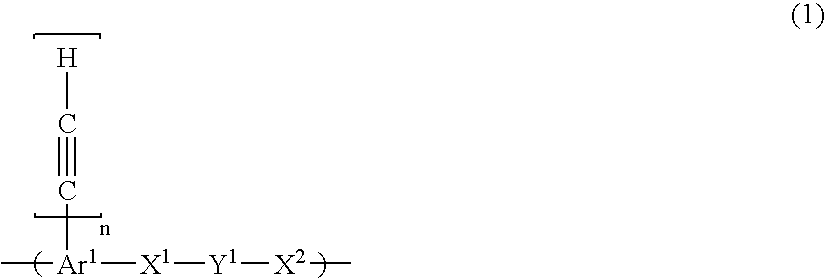Composition for porous organic film
a porous organic film and composition technology, applied in the direction of liquid surface applicators, pretreated surfaces, coatings, etc., can solve the problems of propagation delay, cross-talk noise, and not being fully satisfactory
- Summary
- Abstract
- Description
- Claims
- Application Information
AI Technical Summary
Benefits of technology
Problems solved by technology
Method used
Image
Examples
production example 1
Synthesis of Aromatic Polymer A1
Into a 500 mL four-necked flask was charged 9,9-bis(4-dihydroxyphenyl)fluorene (9.6 g), 1-(trimethylsilylethynyl)-2,4-difluorobenzene (5.4 g), potassium carbonate (10.4 g), dimethyl sulfoxide (150 g) and toluene (80 g), then, they were reacted at 120° C. for 12 hours, at 130° C. for 2 hours, and at 150° C. for 4 hours. Thereafter, the reaction solution was added to a methanol / acetic acid solution, to precipitate a product. The precipitated resin was filtrated, then, washed with methanol and water, and dried to give a resin. The weigh-average molecular weight of the C≡C bond-containing aromatic polyether resin based on a polystyrene calibration standard was about 7600, and the 1H NMR spectrum supported the fact that a trimethylsilyl group was released to give a HC≡C group. This is called aromatic polymer A1.
production example 2
Synthesis of Compound A2
Into a 500 mL four-necked flask was charged 1,2,4,5-tetrabromobenzene (19.7 g) together with triethylamine (250 g) and Cu(I)I (1.1 g) without any treatment, and they were left under Ar flow for 1 hour. Pd(0) (TPP) 4 (3.3 g), trimethylsilylacetylene (10.8 g) and phenylacetylene (11.3 g) were added, and the mixture was maintained at 80° C. for 6 hours while stirring, then, stirred at room temperature overnight. The solution was filtrated, the liquid layer was distilled off with a solvent, then, treated in a column with a toluene solvent, and concentrated to obtain a crystal. To this crystal were added 100 g of methanol and 50 g of toluene and they were dissolved, further potassium carbonate (41.5 g) was added and the mixture was stirred overnight. It was neutralized with acetic acid, and washed with water, then, concentrated to obtain the intended substance. This is called compound A2.
production example 3
Synthesis of Compound A3
Into a 500 mL four-necked flask was charged 9,9-bis(4-dihydroxyphenyl)fluorene (28.0 g), 1-(phenylethynyl)-3,5-difluorobenzene (15.2 g), K2CO3 (29.6 g), dimethyl sulfoxide (429 g) and toluene (229 g), and the mixture was subjected to dehydration under reflux, then, reacted at 180° C. for 4 hours. Then, the reaction solution was added to a methanol / acetic acid solution to precipitate a product. The precipitated resin was filtrated, then, washed with methanol and water, and dried to obtain a resin. The weigh-average molecular weight of the C≡C bond-containing aromatic polyether resin based on a polystyrene calibration standard was about 8500, and this is called compound A3.
PUM
| Property | Measurement | Unit |
|---|---|---|
| Temperature | aaaaa | aaaaa |
| Fraction | aaaaa | aaaaa |
| Pressure | aaaaa | aaaaa |
Abstract
Description
Claims
Application Information
 Login to View More
Login to View More - R&D
- Intellectual Property
- Life Sciences
- Materials
- Tech Scout
- Unparalleled Data Quality
- Higher Quality Content
- 60% Fewer Hallucinations
Browse by: Latest US Patents, China's latest patents, Technical Efficacy Thesaurus, Application Domain, Technology Topic, Popular Technical Reports.
© 2025 PatSnap. All rights reserved.Legal|Privacy policy|Modern Slavery Act Transparency Statement|Sitemap|About US| Contact US: help@patsnap.com



